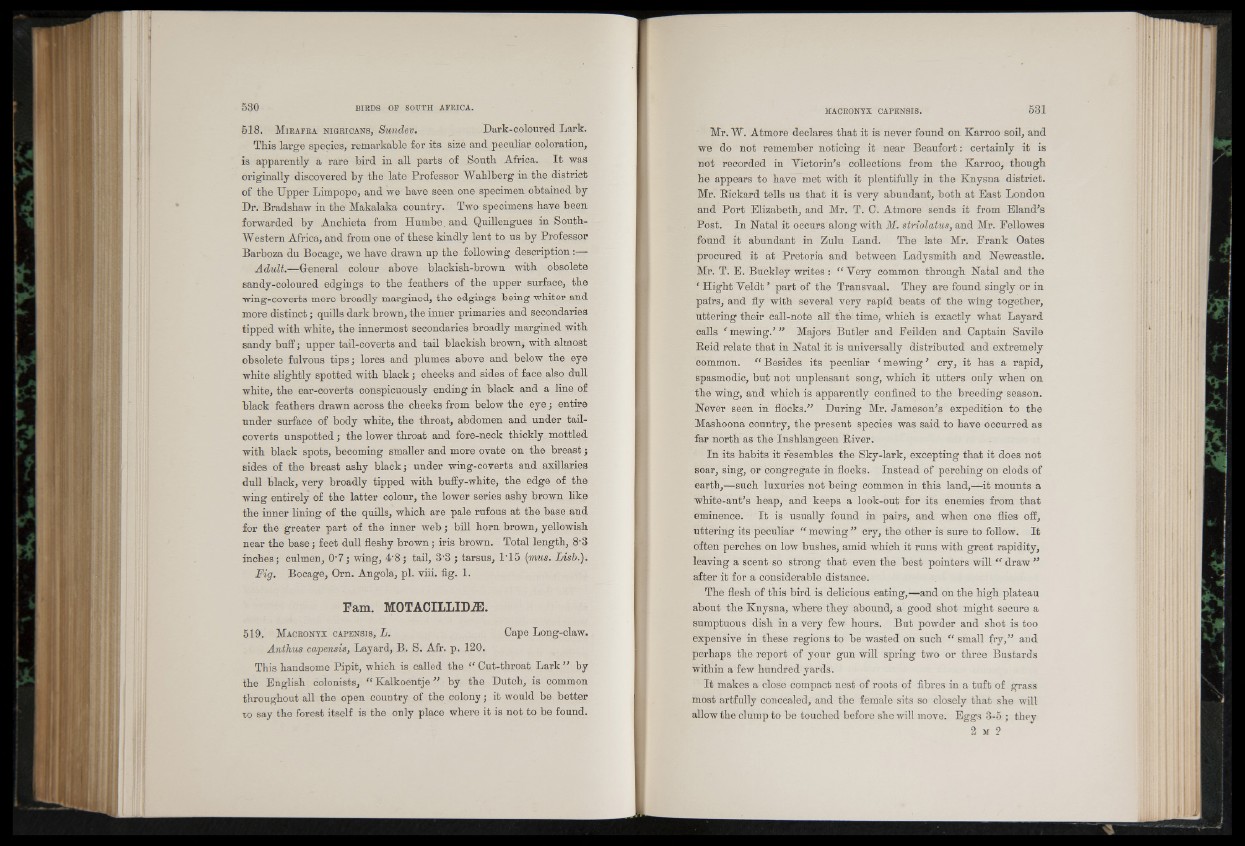
518. M ira fra n igrica n s , Sundev. Dark-coloured Lark.
This large species, remarkable for its size and peculiar coloration,
is apparently a rare bird in all parts of South Africa. I t was
originally discovered by the late Professor Wahlberg in the district
of the Upper Limpopo, and we have seen one specimen obtained by
Dr. Bradshaw in the Makalaka country. Two specimens have been
forwarded by Anchieta from Hurnbe and Quillengues in South-
Western Africa, and from one of these kindly lent to us by Professor
Barboza du Bocage, we have drawn up the following description:—
Adult.—General colour above blackish-brown with obsolete
sandy-coloured edgings to the feathers of the upper surface, the
wing-coverts more broadly margined, the edgings being whiter and
more distinct; quills dark brown, the inner primaries and secondaries
tipped with white, the innermost secondaries broadly margined with
sandy buff; upper tail-coverts and tail blackish brown, with almost
obsolete fulvous tips; lores and plumes above and below the eye
white slightly spotted with black; cheeks and sides of face also dull
white, the ear-coverts conspicuously ending in black and a line of
black feathers drawn across the cheeks from below the eye; entire
under surface of body white, the throat, abdomen and under tail-
coverts unspotted; the lower throat and fore-neck thickly mottled
with black spots, becoming smaller and more ovate on the breast;
sides of the breast ashy black; under wing-coverts and axillaries
dull black, very broadly tipped with buffy-white, the edge of the
wing entirely of the latter colour, the lower series ashy brown like
the inner lining of the quills, which are pale rufous at the base and
for the greater part of the inner web; bill horn brown, yellowish
near the base; feet dull fleshy brown; iris brown. Total length, 8'3
inches; culmen, 0'7; wing, 4'8; tail, 3’3 ; tarsus, 1T5 (mus. Lisb.).
Fig. Bocage, Orn. Angola, pi. viii. fig. 1.
Fam. MOT ACILLID2E.
519. M acronyx capensis, L. Cape Long-claw.
Anthus capensis, Layard, B. S. Afr. p. 120.
This handsome Pipit, which is called the “ Cut-throat Lark” by
the English colonists, “ Kalkoentje ” by the Dutch, is common
throughout all the open country of the colony; it would be better
io say the forest itself is the only place where it is not to be found.
Mr. W. Atmore declares that it is never found on Karroo soil, and
we do not remember noticing it near Beaufort: certainly it is
not recorded in Victorinas collections from the Karroo, though
he appears to have met with it plentifully in the Knysna district.
Mr. Rickard tells us that it is very abundant, both at East London
and Port Elizabeth, and Mr. T. 0. Atmore sends it from Eland’s
Post. In Natal it occurs along with M. striolatus, and Mr. Eellowes
found it abundant in Zulu Land. The late Mr. Frank Oates
procured it at Pretoria and between Ladysmith and Newcastle.
Mr. T. E. Buckley writes : “ Very common through Natal and the
‘ Hight Veldt ’ part of the Transvaal. They are found singly or in
pairs, and fly with several very rapid beats of the wing together,
uttering their call-note all the- time, which is exactly what Layard
calls ‘ mewing.’ ” Majors Butler and Eeilden and Captain Savile
Reid relate that in Natal it is universally distributed and extremely
common. “ Besides its peculiar c mewing ’ cry, it has a rapid,
spasmodic, but not unpleasant song, which it utters only when on
the wing, and which is apparently confined to the breeding season.
Never seen in flocks.” During Mr. Jameson’s expedition to the
Mashoona country, the present species was said to have occurred as
far north as the Inshlangeen River.
In its habits it resembles the Sky-lark, excepting that it does not
soar, sing, or congregate in flocks. Instead of perching on clods of
earth,—such luxuries not being common in this land,—it mounts a
white-ant’s heap, and keeps a look-out for its enemies from that
eminence. It is usually found in pairs, and when one flies off,
uttering its peculiar “ mewing ” cry, the other is sure to follow. It
often perches on low bushes, amid which it runs with great rapidity,
leaving a scent so strong that even the best pointers will “ draw ”
after it for a considerable distance.
The flesh of this bird is delicious eating,—and on the high plateau
about the Knysna, where they abound, a good shot might secure a
sumptuous dish in a very few hours. But powder and shot is too
expensive in these regions to be wasted on such “ small fry,” and
perhaps the report of your gun will spring two or three Bustards
within a few hundred yards.
It makes a close compact nest of roots of fibres in a tuft of grass
most artfully concealed, and the female sits so closely that she will
allow the clump to be touched before she will move. Eggs 3-5 ; they
2 m 2